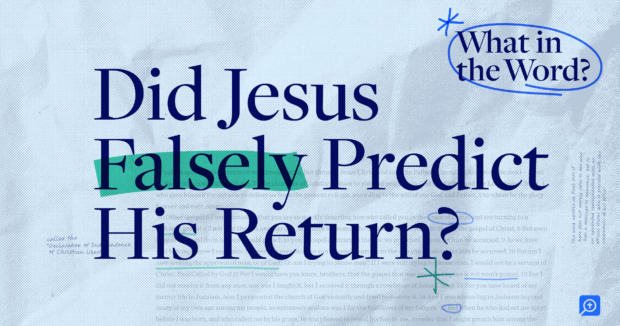On this episode of What in the Word?, Kirk E. Miller is joined by New Testomony scholar Jeannine Brown to discover one in every of Scripture’s most difficult passages: Matthew 16:28. Did Jesus mistakenly predict his return? Collectively, they look at numerous interpretations—such because the transfiguration, the resurrection, Pentecost, the autumn of Jerusalem, and the second coming—and talk about probably the most compelling understanding of Jesus’s phrases. Tune in to realize readability and discover ways to apply and educate this often-misunderstood verse.
Observe the present on YouTube, Spotify, Apple Podcasts, and extra.
Particular presents


A Free Ebook Only for You
Logos has given away over 5 million free books, empowering Christians globally to check deeply. Get a shiny, new free e-book each month!


Unique Lexham Press Robust Texts Bundle
Have extra questions in regards to the Bible? Get the 10-volume Lexham Press Robust Texts Bundle designed solely for followers of What within the Phrase?
Join with us
Prepared to extend biblical literacy? Like and share. To go the additional mile, go away us a overview in your most popular platform.
Subscribe to get future episodes. (Bonus: We’ll ship you a reduction to make use of in your first buy.)
Thanks for subscribing to Phrase by Phrase!
Use code WORDBYWORD to save lots of 10% in your first order.
WORDBYWORD
Copy code
Episode visitor: Jeannine Brown
Dr. Jeannine Brown is the David Worth Professor of Biblical and Theological Foundations at Bethel Seminary, the place she has taught for 25 years. She focuses her analysis on the New Testomony, hermeneutics, and integration. She is a member of the NIV translation committee.
She is married to Tim, and so they have two grownup daughters, two sons-in-law, and two grandchildren.
Episode synopsis
The issue: Did Jesus make a false prediction?
In Matthew 16:28, Jesus says that a few of his disciples won’t die earlier than they see the Son of Man “coming in his kingdom.” At first look, this verse may appear to counsel that Jesus predicted that he would bodily return inside the lifetime of the apostles—one thing that, in fact, didn’t occur. The same assertion in Matthew 10:23 intensifies the declare: “You’ll not end going by way of the cities of Israel earlier than the Son of Man comes.”
These statements elevate tough theological and interpretive questions. If Jesus was referring to his remaining return, then both he was flawed or not less than Matthew’s account is. This turns into a major difficulty, then, for these Christians who affirm the inerrancy of Scripture and the divinity of Christ.
How will we reconcile these items?
The context of Matthew 16
Jeannine Brown begins by strolling us by way of the encompassing context of Matthew 16:27–28:
- In Matthews 16:13–20, Peter rightly confesses Jesus because the Messiah.
- In 16:21–23, Jesus articulates the cruciform nature of his messiahship, and Peter wrongly rebukes him.
- In 16:24–26, Jesus explains that those that would comply with this cruciform Messiah should likewise take up their crosses.
As Kirk E. Miller notes, Matthew 16:27–28 seem to pivot the dialogue abruptly to this point out of the Son of Man coming in his kingdom. However, as we’ll see, when learn in gentle of the broader narrative—Jesus’s path from struggling to glory—the inclusion of vv. 27–28 right here suits fairly naturally.
The important thing phrase: “Son of Man coming in his kingdom”
Many instinctively interpret “the Son of Man coming” (Matt 16:28; see additionally Matt 10:23) as referring to Jesus’s second coming, his bodily return on the finish of historical past. Nevertheless, Jeannine notes that this assumption must be examined.
To that finish, Jeannine and Kirk discover the next six interpretative choices.
1. The transfiguration
Some perceive “the Son of Man coming” to confer with Christ’s transfiguration in Matthew 17:1–13, occurring instantly after Matthew 16:28. The proximity of those textual content supplies a powerful narrative and thematic connection. In accordance with this view, transfiguration is Christ’s coming in his kingdom in as a lot because it reveals and prefigures the glory of Christ’s future exalted state.
Solely three disciples—Peter, James, and John—witness Jesus on this glorified state, becoming Jesus’s assertion that “some” would see his kingdom earlier than their demise.
2. The resurrection
Others interpret Christ’s “coming in his kingdom” as a reference to his resurrection. Jesus’s resurrection embodies and inaugurates the dominion and on this sense is its “coming,” reflecting the already-but-not-yet nature of God’s kingdom. The resurrection serves as Christ’s climactic vindication and enthronement language (see Rom 1:4). This view is supported by Matthew 28:18, the place Jesus, after his resurrection, states, “All authority in heaven and on earth has been given to me.”
3. Pentecost & the approaching of the Spirit
Some see this “coming in his kingdom” as referring to the approaching of the Spirit at Pentecost (Acts 2). As Acts 2:33 exhibits, the pouring out of the Spirit evidences Christ’s enthronement and is an additional installment of his kingdom’s energy.
Nevertheless, since Matthew’s Gospel doesn’t itself embody any reference to Pentecost (a Lukan theme), Jeannine and Kirk level out that it’s much less probably that Matthew supposed his viewers to make this connection, seeing Acts 2 because the success of Matthew 16:28.
4. The mission of the church
One other proposed interpretation sees this “coming” because the unfold of the gospel within the early church. For instance, Acts outlines the gospel’s advancement to all through the recognized world (see the programmatic assertion in Acts 1:8).
Whereas this view is believable primarily based on Acts and Paul’s writings, it once more lacks robust narrative cues in Matthew’s Gospel.
5. The destruction of the temple in AD 70
Many perceive Jesus to be referring to the destruction of the temple in AD 70. In accordance with this view, the destruction of Jerusalem is a divine visitation, Christ “coming” in judgment. And Jesus’s judgment upon Jerusalem right here acts as an expression of his kingship.
This view is supported by parallels in Matthew’s Olivet Discourse, additionally interpreted as referring to Christ’s coming to Jerusalem in judgment reasonably than his future, bodily return. Specifically, the equal “Son of Man” and “coming” language is utilized in Matthew 24:30 together with the same assertion in Matthew 24:34 that “this era won’t go away” earlier than these occasions happen. This means that Matthew 24 and Matthew 16:28 confer with the identical occasion.
6. Christ’s bodily coming
Lastly, some interpret Jesus’s reference to his “coming” as a (false) prediction of his bodily return, one thing that didn’t happen inside the disciples’ lifetimes. Interpreters declare Jesus was mistaken or attribute the error to Matthew.


Examine the distinct makes use of of ἔρχομαι and παρουσία in Matthew’s Gospel.
The significance of Daniel 7
To grasp Jesus’s language, Jeannine emphasizes Daniel 7:13–14.
First, in Daniel’s imaginative and prescient, this “coming” is an upward motion towards enthronement, not a downward return. One “like a Son of Man” comes to the Historical of Days (to not earth) and is given authority and glory.
Second, the Greek Septuagint of Daniel 7 makes use of the phrase ἔρχομαι for “coming,” the identical phrase Matthew makes use of in Matthew 16:28. In distinction, Matthew reserves the term παρουσία (parousia) particularly for Jesus’s remaining return (e.g., Matt 24:37).
Understanding this distinction helps resolve a lot confusion. The “coming” in 16:28, then, is greatest learn not as Jesus’s bodily return to earth (what Matthew elsewhere designates παρουσία) however as his vindication, exaltation, and enthronement, because the allusion to Daniel 7:13–14 suggests.
A layered or “horizons” success
Jeannine proposes that Matthew 16:28 displays a layered or multi-horizon success. Quite than predicting one discrete occasion, the passage refers to a course of, or installments, of vindication. Every occasion (the transfiguration, resurrection, coming in judgement upon Jerusalem, and so forth.), in its personal manner, reveals the Son of Man coming in energy and authority.
Deciphering Matthew 10:23
We now briefly return to the parallel passage, Matthew 10:23: “You’ll not end going by way of the cities of Israel earlier than the Son of Man comes.” Jeannine situates this verse inside the mission discourse addressed to the twelve disciples (Matt 10:1). It considerations their ministry to Israel, not the Gentiles. The phrase then probably refers to an impending vindication occasion inside their lifetimes—once more pointing to the resurrection or the temple’s destruction.
Theological & sensible significance
Why does this passage matter?
- It affirms Jesus’s trustworthiness. He was not mistaken. When interpreted rightly, his phrases are true.
- It strengthens our Christology. Jesus is the struggling Messiah who’s vindicated by God.
- It reinforces discipleship themes. Following Christ means struggling now, however glory later. That is the Son of Man’s path. We comply with in his footsteps.
- It encourages hope. Jesus’s vindication ensures our future glorification.
Kirk highlights how these themes resonate in texts like Romans 8 and Philippians 3. The church is known as to comply with the crucified and risen Messiah, with confidence that God may even vindicate those that stay devoted.
Instructing & preaching ideas
Kirk and Jeannine supply steering for these preaching this passage:
- Don’t skip tough verses. Wrestle with them fastidiously.
- Discover Outdated Testomony backgrounds—particularly Daniel 7.
- Spotlight the motion from struggling to glory.
- Emphasize how Jesus’s vindication empowers our perseverance.
When taught nicely, Matthew 16:28 turns into not a legal responsibility however a wealthy useful resource for encouraging deeper confidence in Jesus’s—and by extension, our personal—id and mission.
Conclusion
Jesus’s assertion in Matthew 16:28 just isn’t a failed prediction however a theologically wealthy affirmation of his coming vindication. When learn by way of the lens of Daniel 7 and inside the literary movement of Matthew’s Gospel, the verse contributes to our understanding of the kingdom, the id of the Son of Man, and the hope now we have as his followers.
Logos values considerate and interesting discussions on essential biblical subjects. Nevertheless, the views and interpretations introduced on this episode are these of the people talking and don’t essentially replicate the official place of Logos. We acknowledge that Christians might maintain completely different views on this passage, and we welcome various engagement and respectful dialogue.
Really useful assets from Brown for learning Matthew
Extra beneficial assets on Matthew from Kirk
Source link














